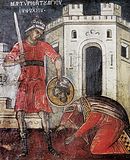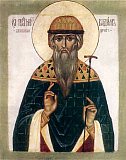

| Previous day | Next day |
| Old Style
April 9
|
Saturday |
New Style
April 22
|
| Bright Week. Fast-free period. | No fast.
|
![]() Martyr Eupsychius of Caesarea in Cappadocia (362).
Martyr Eupsychius of Caesarea in Cappadocia (362).
Hieromartyrs Desan, bishop, and Mariabus, priest, and Martyrs Abdiesus and 270 others, in Persia (362-364). Hieromartyr Bademus (Vadim), archimandrite, of Persia (376). Hieromartyr Misael, archbishop of Ryazan and Murom (1655).
Martyrs Fortunatus, Donatus, twelve virgins, and six laymen, at Sirmium (304). St. Acacius, bishop of Amida in Mesopotamia (5th c.). St. Woutruide (Waldetrudis), monastic foundress at Bergen (Netherlands) (688). Newly Revealed Martyrs Raphael, Nicholas, and Irene, of Mytilene (1463).
Thoughts for Each Day of the Year
According to the Daily Church Readings from the Word of God
By St. Theophan the Recluse

Saturday. [Acts 3:11–16; John 3:22–33]
We have two lives, fleshly and spiritual. Our spirit is as though buried in our flesh. Once it begins to extract itself—coming to life by God’s grace—from its intertwining with the flesh and to appear in its spiritual purity, then it will be resurrected, or it will resurrect itself piece by piece. When it wholly tears itself out of this binding, then it comes forth as if from a tomb, in a renewed life. In this manner the spirit becomes separate, alive and active; whereas the tomb of the flesh is separate, dead and inactive, though both are in the same person. This is the mystery of what the apostle says: where the Spirit of the Lord is, there is liberty (II Cor. 3:17). This is liberty from decay, which surrounds our incorruptible spirit; or from passions, corrupting our nature. This spirit, entering into the freedom of the children of God is like a beautifully coloured butterfly, fluttering away from its cocoon. Behold its rainbow colouring: love, joy, peace, longsuffering, gentleness, goodness, faith, meekness, temperance (Gal. 5:22). Is it possible for such a beauty of perfection not to arouse in us a desire to emulate it?
Articles
 Martyr Eupsychius of Caesarea, in CappadociaThe Holy Martyr Eupsychius was born in the city of Caesarea in Cappadocia and received a Christian upbringing by his illustrious parents. |
 Martyr Desan the Bishop and 272 others in PersiaThe Holy Martyrs Bishop Desan, Presbyter Mariabus, Abdiesus, and 270 others were put to death under the Persian emperor Sapor II. |
 Monkmartyr Bademus (Vadim) of PersiaMonk Martyr Archimandrite Bademus (Vadim) was born in the fourth century in the Persian city of Bithlapata, and was descended from a rich and illustrious family. |

